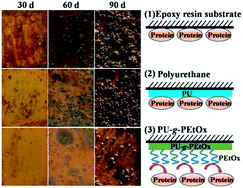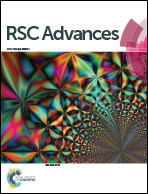Degradable polyurethane with poly(2-ethyl-2-oxazoline) brushes for protein resistance†
Abstract
Linear poly(2-ethyl-2-oxazoline) (PEtOx) with two hydroxyl groups located at the ends of each chain [PEtOx(OH)2] was synthesized by cationic ring-opening polymerization (CROP) using 2,2-bis(hydroxymethyl)propionic acid as the end-capping agent. Further co-polycondensation of PEtOx and poly(ε-caprolactone) (PCL) led to degradable polyurethane-graft-poly(2-ethyl-2-oxazoline) (PU-g-PEtOx) with PCL as the soft segment. The structures of PU-g-PEtOx with different graft densities of PEtOx as well as different chain lengths were confirmed by various characterization techniques. Moreover, protein resistance experiments were examined by a quartz crystal microbalance with dissipation (QCM-D). The results demonstrated that the adsorption of three model proteins decreased with the increase in chain length of PEtOx when PU-g-PEtOx possessed the same PEtOx graft density while the adsorption of proteins decreased with the increase in the graft density of PEtOx when the chain length was fixed. The adsorption of proteins on PU-g-PEtOx was reduced by 97% compared with that on unmodified PU. The degradation of PU-g-PEtOx was monitored by a combination of ellipsometry and QCM-D because of the biodegradation of PCL segments. Furthermore, marine field tests were also performed during the rich fouling season and our results showed that PU-g-PEtOx exhibited much better anti-biofouling performance than unmodified PU.


 Please wait while we load your content...
Please wait while we load your content...